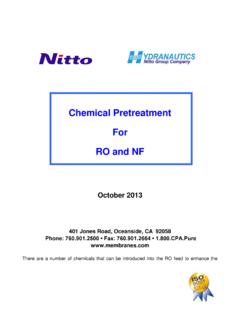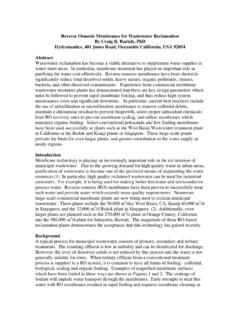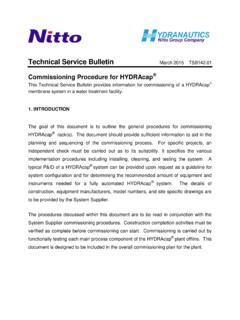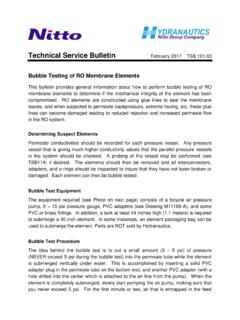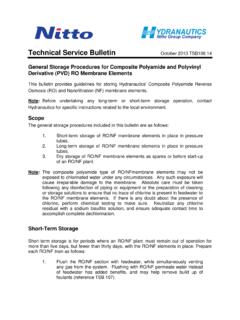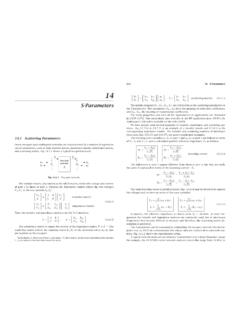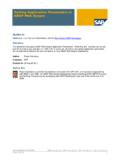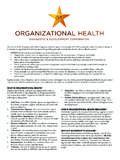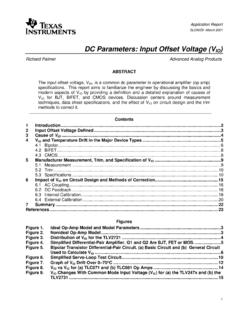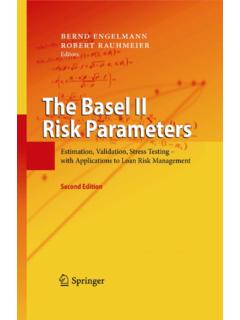Transcription of Design Parameters Affecting Performance - Hydranautics
1 Page 1 of 5 01/23/01 Design Parameters Affecting Performance The Performance of membrane elements operating in a reverse osmosis system is affected by the feed water composition, feed temperature, feed pressure, and permeate recovery ratio. Membrane compaction and fouling also affect membrane Performance . Performance at a given set of system operating Parameters can be calculated from nominal membrane Performance at reference test conditions. I. FEED WATER SALINITY Some RO systems experience fluctuation of feed water composition during operation.
2 This may be due to seasonal fluctuation of feed water salinity supplies, or due to intermittent operation of a number of water sources of different salinity. As long as different feed water compositions will not require a change in the system recovery ratio, changing feed water composition will affect only the required feed pressure and permeate water salinity. The chart below shows the change in required feed pressure and projected permeate salinity as a function of feed salinity for a system operating at an average flux rate of 15 gfd and recovery rate of 85%.
3 Calculations were made for two membrane types: ESPA and CPA2. The ESPA membrane has specific flux of gfd/psi net, which is twice as high as specific flux of CPA2 membrane. It can be seen that for both membranes feed pressure and permeate salinity increase with feed salinity in a similar way. The rate of increase in permeate salinity is higher than the rate of increase in feed pressure. If the different feed water also contains concentrations of sparingly soluble salts higher than in the Design feed water, then the recovery ratio may have to be reduced to avoid the possibility of precipitation of scale from the concentrate stream.
4 Page 2 of 5 01/23/01 EFFECT OF FEED SALINITY ON SYSTEM PERFORMANCEFLUX 15 GFD, CPA2 AND ESPA MEMBRANES0501001502002503003500100020003 000400050006000 FEED SALINITY, PPM TDSFEED PRESSURE (PSI) AND PERMEATE SALINITY (PPM TDS)Permeate salinityFeed pressureCPA2 CPA2 ESPAESPA II. FEED PRESSURE RO systems equipped with spiral wound membrane elements are designed to operate at a constant flux rate ( , to produce a constant permeate flow). Over operating time, the feed pressure is adjusted to compensate for fluctuation of feed water temperature, salinity and permeate flux decline due to fouling or compaction of the membrane.
5 For the purpose of specifying the high pressure pump, it is usually assumed that specific flux of the membrane will decline by about 20% in three years. The pump has to be designed to provide feed pressure corresponding to the initial membrane Performance and to compensate for expected flux decline. If the RO system is equipped with centrifugal pump, then the conventional approach is to use an oversized pump and regulate feed pressure by throttling (partially close the feed valve).
6 Today an increasing number of RO system use electric motors with variable speed drives, which enable adjustment of flow and feed pressure of the pump over a wide range with very little loss in efficiency. The variable speed drive reduces unproductive pressure losses which were common in the past. Some RO systems use positive displacement pumps (piston or plunger pumps) as a high pressure process pump. The positive displacements pumps enable regulation of feed pressure at constant pump output, with little change of pump efficiency.
7 Positive displacement pumps are less common in RO systems due to capacity limitation Page 3 of 5 01/23/01 of this pump type, high frequency of required maintenance, noisy operation and strong vibrations. III. FEED WATER TEMPERATURE Change in feed water temperature results in the change in the rate of diffusion through the membrane. The change in the permeate flux rate with temperature is described by the following equation: TCF = exp(K*(1/(273+t) - 1/298)) (1) Where TCF is temperature correction factor, K is a constant characteristic for a given membrane material, and t is feed water temperature in degrees Celsius.
8 In this equation, a temperature of 25 C is used as a reference point, with TCF = 1. The change in flux rate with temperature for polyamide membranes is shown in the following graph. FLUX CHANGE WITH 1015 20 2530 3540 45 FEED WATER TEMPERATURE, CRELATIVE FLUX RATE The rate of change is about 3% per degree. Since RO systems are Design to operate at constant output, feed pressure is adjusted to compensate for water flux changes when temperature changes. The salt diffusion through the membrane changes with temperature approximately at the same rate as water flux.
9 Because permeate flux is maintained constant, permeate salinity changes accordingly to the temperature fluctuations. Page 4 of 5 01/23/01 TEMPERATURE EFFECT ON MEMBRANE PERFORMANCE05010015020025030005101520253 0354045 FEED TEMPERATURE, CFEED PRESSURE (PSI) AND PERMEATE SALINITY (PPM TDS)CPA PRESSURECPA SALINITYESPA PRESSUREESPA SALINITYFEED SALINITY 1500 PPM TDS,RECOVERY RATE 85% Effect of feed water temperature on RO system feed pressure and permeate salinity is illustrated above. The calculations of operating Parameters were conducted for an RO system operating at 85% recovery rate, using two membrane types; high salt rejection CPA2 and high permeate flux ESPA.
10 The general trend of Performance change is similar for both membrane types. However, as expected the difference of feed pressure between two membranes increases with decrease of temperature. The permeate salinity changes in opposite way. The absolute value and difference between two membranes increases with feed water temperature. IV. PERMEATE RECOVERY RATIO Recovery ratio affects system Performance , permeate salinity and feed pressure, by determining the average feed salinity.

